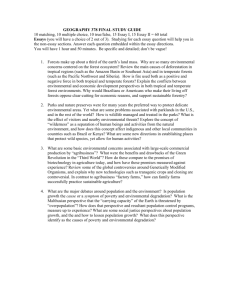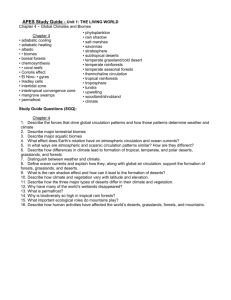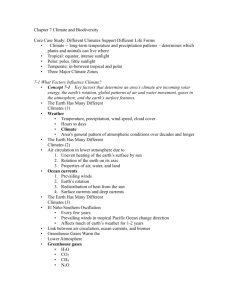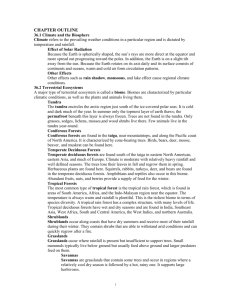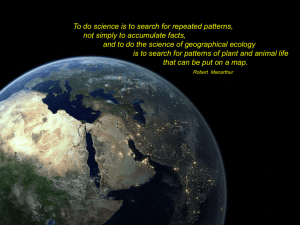Major Climax Ecosystems (Biomes)
advertisement
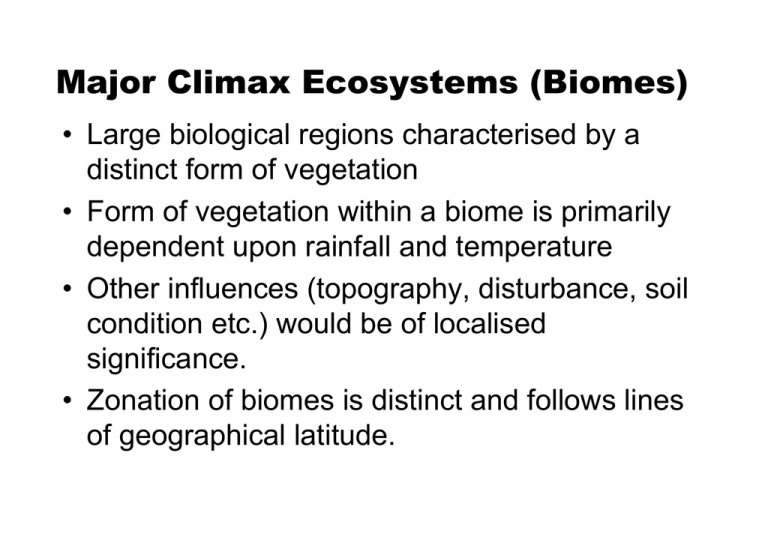
Major Climax Ecosystems (Biomes) • Large biological regions characterised by a distinct form of vegetation • Form of vegetation within a biome is primarily dependent upon rainfall and temperature • Other influences (topography, disturbance, soil condition etc.) would be of localised significance. • Zonation of biomes is distinct and follows lines of geographical latitude. ARID DESERT • may be due to rain shadow, geographical location or atmospheric circulation patterns • dominant plants are succulents • desert animals characterised by adaptations for retention of moisture • temperature extremes (due to absence of cloud cover) are common • permanent aridity: precipitation is infrequent or irregular HOT DESERTS •Hot deserts occur in those regions to the north and south of the equatorial belt that lie beneath descending dry air masses. They also are found in the lee of mountains, where air is forced to rise, cool, and lose moisture as rain falling on windward slopes. •These deserts experience very high temperatures by day, especially in summer, while night temperatures fall dramatically. •Hot deserts are found in the southwestern United States, in North Africa, the Middle East, and along the west coast of South America. TEMPERATE DESERTS •Temperate or cold deserts occur in temperate regions where temperatures colder than those of hot deserts are experienced. •These dry environments are caused by either remoteness from a coast, which results in low atmospheric humidity from lack of onshore winds, or the presence of high mountains separating the desert from the coast. •The major region in which temperate deserts are located is Central Asia. Smaller areas occur in western North America, southeastern South America, and southern Australia. TUNDRA •vegetation composed mainly of lichens, mosses, grasses & shrubs. No trees are present. •layer of permafrost beneath soil •low annual rainfall (c. 25 mm yr-1) •strong winds •long, very cold winters •very slow decomposition due to cold temperatures •nutrient-deficient, waterlogged soils Tundra •Found mainly in the low polar regions of North America and Eurasia •Most regions are fully vegetated by dwarf shrubs, lichens and mosses POLAR BARRENS •Polar barrens are found in the High Arctic region of North America and Eurasia. •These ecosystems have a shorter growing season, cooler summers, half the number of vascular plants, and fewer species overall than tundra ecosystems. GRASSLAND • cover extensive areas in the interiors of continents • diversity of grasses within a grassland depends on availability of moisture. Higher annual precipitation generates higher diversity of grasses • may be characterised by scattered trees and shrubs especially close to river banks • proportion of trees reflects competition for water with grasses TROPICAL GRASSLANDS •Tropical grasslands, which generally lie between areas of tropical forest and desert, are located in the Sahel south of the Sahara, in East Africa, and in Australia. •They occur in the same regions as savannas, and the distinction between the two is somewhat arbitrary. TEMPERATE GRASSLANDS •Temperate grasslands are usually found between deserts and temperate forests. •At their edges a scattering of shrubs and trees often grows, blurring their boundaries. •These ecosystems are somewhat drier and colder than tropical grasslands. •Principal regions of temperate grasslands are found in North America, Argentina, and across a broad band from Ukraine to China. •Most grasslands have been altered significantly by human activities. WET SAVANNAS •Wet savannas have a dry season that lasts less than half the year, between three to five months. •These ecosystems tend to have more trees dispersed throughout than those systems with longer periods of dryness. •Typical wet savannas are those in Asia and tropical America that occur closest to rainforests. DRY SAVANNAS •The length of the dry season in dry savannas lasts between five and seven months. • The savannas of Africa, which grade almost imperceptibly into grasslands, are in general dry types, as are the savannas of Australia that have a markedly sclerophyllous vegetation. MEDITERRANEAN SCRUBLANDS •Mediterranean scrublands occur in those areas that have a Mediterranean climate, which is warm temperate, with mild, wet winters and long, dry summers. •They occur not only in the Mediterranean region, but in parts of California, where they are called chaparral, and Chile, where they are called chaco or matorral. SCRUBLAND / SHRUBLAND • occur in Mediterranean climates • climate generally semi-arid • vegetation characterised by adaptations for reducing water loss • growth during winter and dormancy/survival during dry season CHENOPOD SCRUBLANDS Chenopod scrublands are named for the dominant shrubs of these landscapes, the members of the Chenopodiaceae, or saltbush, family. They grow typically in saline, semiarid regions of Australia where the predominant season of rainfall is usually, but not invariably, winter. These scrublands found in areas south of 23° 27 S where average rainfall is between 150 to 250 millimetres, cover about 6 percent of the continent. MALLEE SCRUBLANDS Mallee scrublands grow in Australia and are named for the shrub-form eucalyptus called mallees, which are the dominant plants. These scrublands grow in eastern and western Australia between latitudes 30° and 36° S that receive between 200 and 750 millimetres of rain annually. Rainfall in winter months is more variable than that of regions with a Mediterranean climate. FYNBOS SCRUBLAND The fynbos is found between latitudes 32° and 34° S in southwestern South Africa. Although this area has the rainfall deficit in summer months typical of the Mediterranean climate, the nutrient-poor soils are believed to be the primary environmental factor responsible for the vegetation. SCLEROPHYLLOUS FORESTS •Sclerophyllous forests are dominated by a type of evergreen vegetation that has either small, hard, thick leaves or leaves that dangle pendulously from limbs-strategies that slow the loss of water. •These forests occur in regions where rainfall is erratic and winters are generally without frost-principally in Australia and the Mediterranean region. TROPICAL RAINFOREST • High temperatures and high, constant rainfall. Annual rainfall may exceed 4000 mm yr-1 • several very tall trees (> 30 m in height) • Poor undergrowth: canopy intercepts > 99% of incident light • high productivity but poor soils (laterites) • generally characterised by stratification • very little or no seasonality LOWLAND RAINFORESTS Tropical lowland rainforests are vegetation types found in the ever-wet tropics that are dominated by broadleaved evergreen trees. They grow primarily in South and Central America, West and Central Africa, Indonesia, parts of Southeast Asia, and northern Australia. MONTANE AND CLOUD FORESTS Tropical montane forests grow at higher altitudes on forested mountainous regions of the tropics, such as in the highlands of New Guinea, the Gotel Mountains of Cameroon, the Ruwenzori mass of Central Africa, and the Andes of southern Brazil. TROPICAL DECIDUOUS FORESTS Tropical deciduous forests grow in seasonally dry areas of the tropics. These forests occur mainly in India, the Myanmar-Vietnam-southern coastal China region, eastern Brazil, smaller areas in South and Central America north of the Equator, the West Indies, southeastern Africa, and northern Australia. TEMPERATE AND BOREAL FORESTS • • • • occur in moist climates cold winters restrict growth to warm season deciduous habit restricts water loss in winter if evergreen, leaves are adapted to reduce water loss (e.g. Pine needles) • burn-regeneration cycles may be important TEMPERATE BROAD-LEAVED FORESTS •Temperate broad-leaved forests, sometimes called temperate rainforests, are dominated by evergreen vegetation. •These forests grow in regions where yearround rainfall is high and steady and frost is rare. •The main areas of its occurrence are in South America; eastern Australia; southern China, Korea, and Japan; small areas of southeastern North America and southern Africa; and all of New Zealand. TEMPERATE DECIDUOUS FORESTS •Deciduous trees produce leaves that are shed every autumn and are re-grown in the spring. • Forests dominated by these trees show pronounced seasonal changes in appearance, function, and climate. •These forests occur mainly in regions of the Northern Hemisphere where winter temperatures fall well below the freezing point and soils are fertile--primarily in eastern North America, eastern Asia, and western Europe. •Only a few such forests are found in the Southern Hemisphere, such as in some parts of Chile. BOREAL CONIFEROUS FORESTS Boreal coniferous forests are evergreen coniferous forests that often grow just south of the tundra in the Northern Hemisphere where winters are long and cold and days are short. In North America the boreal forest stretches from Alaska across Canada to Newfoundland; it stops just north of the southern Canadian border. The vast taiga of Asia extends across Russia into northeastern China and Mongolia. In Europe it covers most of Finland, Sweden, Norway, and regions in the Scottish Highlands. BOREAL DECIDUOUS FORESTS Boreal deciduous forests are those dominated by deciduous broadleaved species such as birch, aspen, or poplar. Typical forests of this type are the birch forests of far northern North America and Eurasia. MONTANE CONIFEROUS FORESTS Montane coniferous forests are coniferous forests located in the cool high elevations of temperate latitudes, such as those that grow throughout the Rockies in western North America.

